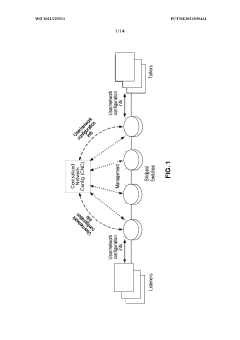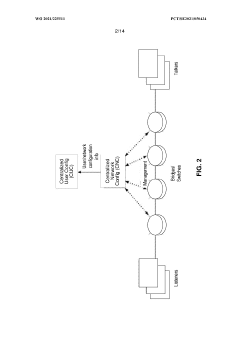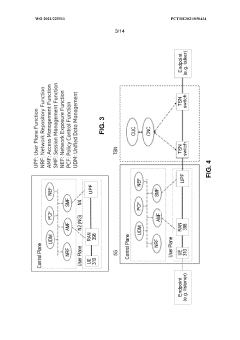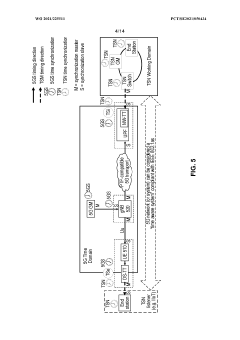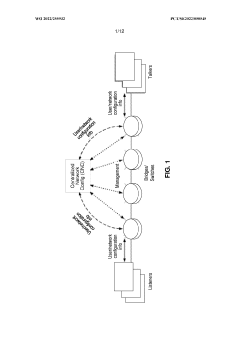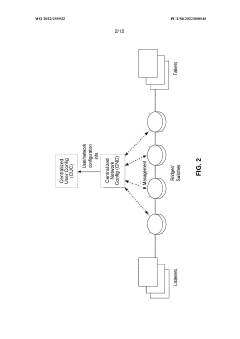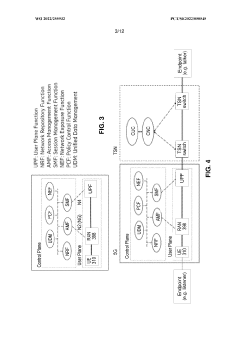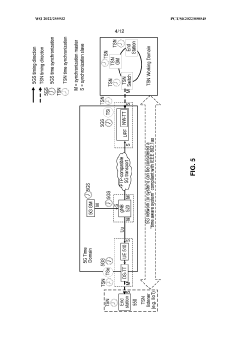How 5G UC Supports Real-Time Monitoring in Nuclear Power Plants
JUL 18, 20259 MIN READ
Generate Your Research Report Instantly with AI Agent
Patsnap Eureka helps you evaluate technical feasibility & market potential.
5G UC in Nuclear Power: Background and Objectives
The integration of 5G Ultra-Reliable Low-Latency Communication (URLLC) technology in nuclear power plants represents a significant advancement in the field of real-time monitoring and control systems. This technological evolution builds upon decades of progress in telecommunications and nuclear safety protocols, aiming to enhance the efficiency, reliability, and safety of nuclear power operations.
The development of nuclear power has been closely tied to advancements in monitoring and control technologies. From the early days of manual controls and analog systems, the industry has steadily moved towards more sophisticated digital solutions. The introduction of 5G UC marks a new era in this progression, offering unprecedented capabilities in terms of data transmission speed, reliability, and low latency.
The primary objective of implementing 5G UC in nuclear power plants is to create a more responsive, accurate, and comprehensive monitoring system. This technology aims to provide real-time data from various sensors and equipment throughout the facility, enabling operators to make informed decisions quickly and effectively. The ultra-low latency of 5G UC is particularly crucial in nuclear environments, where even milliseconds can make a significant difference in responding to potential issues.
Another key goal is to enhance the overall safety and security of nuclear power plants. By leveraging the high bandwidth and network slicing capabilities of 5G, plant operators can establish dedicated, secure communication channels for critical systems. This separation ensures that vital monitoring and control functions are not compromised by network congestion or potential security breaches.
The implementation of 5G UC also aligns with the broader trend of digital transformation in the energy sector. It supports the vision of "smart" nuclear power plants, where advanced analytics, artificial intelligence, and machine learning can be applied to vast amounts of real-time data. This integration is expected to optimize plant performance, predict maintenance needs, and potentially extend the operational lifespan of nuclear facilities.
Furthermore, 5G UC technology in nuclear power plants aims to improve workforce efficiency and safety. Remote monitoring and control capabilities enabled by 5G can reduce the need for human presence in high-risk areas, minimizing exposure to radiation and other hazards. It also facilitates more effective training through augmented and virtual reality applications, enhancing the skills and preparedness of nuclear plant personnel.
As the nuclear power industry faces challenges such as aging infrastructure and public perception concerns, the adoption of cutting-edge technologies like 5G UC is seen as a crucial step in demonstrating the industry's commitment to innovation and safety. This technological leap is expected to play a vital role in shaping the future of nuclear energy, potentially influencing policy decisions and public acceptance of nuclear power as a clean energy source.
The development of nuclear power has been closely tied to advancements in monitoring and control technologies. From the early days of manual controls and analog systems, the industry has steadily moved towards more sophisticated digital solutions. The introduction of 5G UC marks a new era in this progression, offering unprecedented capabilities in terms of data transmission speed, reliability, and low latency.
The primary objective of implementing 5G UC in nuclear power plants is to create a more responsive, accurate, and comprehensive monitoring system. This technology aims to provide real-time data from various sensors and equipment throughout the facility, enabling operators to make informed decisions quickly and effectively. The ultra-low latency of 5G UC is particularly crucial in nuclear environments, where even milliseconds can make a significant difference in responding to potential issues.
Another key goal is to enhance the overall safety and security of nuclear power plants. By leveraging the high bandwidth and network slicing capabilities of 5G, plant operators can establish dedicated, secure communication channels for critical systems. This separation ensures that vital monitoring and control functions are not compromised by network congestion or potential security breaches.
The implementation of 5G UC also aligns with the broader trend of digital transformation in the energy sector. It supports the vision of "smart" nuclear power plants, where advanced analytics, artificial intelligence, and machine learning can be applied to vast amounts of real-time data. This integration is expected to optimize plant performance, predict maintenance needs, and potentially extend the operational lifespan of nuclear facilities.
Furthermore, 5G UC technology in nuclear power plants aims to improve workforce efficiency and safety. Remote monitoring and control capabilities enabled by 5G can reduce the need for human presence in high-risk areas, minimizing exposure to radiation and other hazards. It also facilitates more effective training through augmented and virtual reality applications, enhancing the skills and preparedness of nuclear plant personnel.
As the nuclear power industry faces challenges such as aging infrastructure and public perception concerns, the adoption of cutting-edge technologies like 5G UC is seen as a crucial step in demonstrating the industry's commitment to innovation and safety. This technological leap is expected to play a vital role in shaping the future of nuclear energy, potentially influencing policy decisions and public acceptance of nuclear power as a clean energy source.
Market Demand for Real-Time Nuclear Monitoring
The market demand for real-time nuclear monitoring in power plants has been steadily increasing due to growing concerns about safety, regulatory requirements, and the need for operational efficiency. Nuclear power plants require constant vigilance to ensure safe operation, and real-time monitoring systems play a crucial role in this process.
Safety considerations are the primary driver of market demand for real-time monitoring systems. Nuclear power plants must maintain the highest levels of safety to prevent accidents and protect both workers and surrounding communities. Real-time monitoring allows for immediate detection of any anomalies or potential issues, enabling rapid response and mitigation of risks.
Regulatory bodies worldwide have been tightening requirements for nuclear power plant operations, particularly in the wake of incidents like the Fukushima disaster. These regulations often mandate the implementation of advanced monitoring systems to ensure compliance with safety standards. This regulatory pressure has created a significant market demand for state-of-the-art monitoring solutions.
Operational efficiency is another key factor driving the demand for real-time monitoring systems. Nuclear power plants are complex facilities with numerous interconnected systems. Real-time monitoring allows operators to optimize performance, reduce downtime, and extend the lifespan of critical components. This translates to improved cost-effectiveness and increased energy output.
The integration of 5G technology in real-time monitoring systems has opened up new possibilities for the nuclear power industry. 5G's ultra-low latency and high bandwidth capabilities enable the transmission of vast amounts of data in real-time, allowing for more comprehensive and responsive monitoring. This has created a growing market for 5G-enabled monitoring solutions specifically tailored for nuclear power plants.
The global nuclear power industry is experiencing growth, particularly in emerging economies, which is further fueling the demand for advanced monitoring systems. As new nuclear power plants are constructed and existing ones undergo modernization, there is a significant opportunity for the implementation of cutting-edge real-time monitoring technologies.
Market analysts predict substantial growth in the nuclear power plant monitoring systems market over the coming years. This growth is attributed to the increasing number of nuclear power plants worldwide, stricter safety regulations, and the need for more efficient operations. The integration of advanced technologies like 5G, AI, and IoT in monitoring systems is expected to drive innovation and create new market opportunities in this sector.
Safety considerations are the primary driver of market demand for real-time monitoring systems. Nuclear power plants must maintain the highest levels of safety to prevent accidents and protect both workers and surrounding communities. Real-time monitoring allows for immediate detection of any anomalies or potential issues, enabling rapid response and mitigation of risks.
Regulatory bodies worldwide have been tightening requirements for nuclear power plant operations, particularly in the wake of incidents like the Fukushima disaster. These regulations often mandate the implementation of advanced monitoring systems to ensure compliance with safety standards. This regulatory pressure has created a significant market demand for state-of-the-art monitoring solutions.
Operational efficiency is another key factor driving the demand for real-time monitoring systems. Nuclear power plants are complex facilities with numerous interconnected systems. Real-time monitoring allows operators to optimize performance, reduce downtime, and extend the lifespan of critical components. This translates to improved cost-effectiveness and increased energy output.
The integration of 5G technology in real-time monitoring systems has opened up new possibilities for the nuclear power industry. 5G's ultra-low latency and high bandwidth capabilities enable the transmission of vast amounts of data in real-time, allowing for more comprehensive and responsive monitoring. This has created a growing market for 5G-enabled monitoring solutions specifically tailored for nuclear power plants.
The global nuclear power industry is experiencing growth, particularly in emerging economies, which is further fueling the demand for advanced monitoring systems. As new nuclear power plants are constructed and existing ones undergo modernization, there is a significant opportunity for the implementation of cutting-edge real-time monitoring technologies.
Market analysts predict substantial growth in the nuclear power plant monitoring systems market over the coming years. This growth is attributed to the increasing number of nuclear power plants worldwide, stricter safety regulations, and the need for more efficient operations. The integration of advanced technologies like 5G, AI, and IoT in monitoring systems is expected to drive innovation and create new market opportunities in this sector.
5G UC Technology: Current State and Challenges
The implementation of 5G Ultra-Reliable Low-Latency Communication (URLLC) in nuclear power plants for real-time monitoring represents a significant technological advancement. However, this cutting-edge application faces several challenges and limitations in its current state.
One of the primary challenges is ensuring the ultra-high reliability required for nuclear power plant operations. While 5G URLLC aims to provide 99.999% reliability, achieving this consistently in the complex and interference-prone environment of a nuclear facility remains a significant hurdle. Electromagnetic interference from various equipment and the dense concrete structures typical in these plants can potentially disrupt 5G signals, affecting the reliability of real-time monitoring systems.
Latency is another critical factor in nuclear power plant monitoring. Although 5G URLLC promises latencies as low as 1 millisecond, maintaining this performance consistently across all areas of a nuclear facility is challenging. Factors such as network congestion, signal propagation through thick walls, and the need for multiple network hops can introduce additional latency, potentially impacting the real-time nature of the monitoring systems.
Security and data privacy present another set of challenges. The sensitive nature of nuclear power plant operations demands the highest levels of cybersecurity. While 5G incorporates advanced security features, the increased connectivity and data flow associated with real-time monitoring systems also increase the potential attack surface for cyber threats. Ensuring end-to-end encryption, secure authentication, and protection against potential jamming or spoofing attacks are ongoing concerns.
Scalability and network capacity pose additional challenges. As the number of connected devices and sensors in a nuclear power plant increases, the 5G network must be capable of handling the massive amount of data generated without compromising on performance or reliability. This requires careful network planning and potentially the deployment of edge computing solutions to manage data processing and reduce network load.
The integration of 5G URLLC with existing legacy systems in nuclear power plants presents another significant challenge. Many facilities operate with older, proprietary systems that may not be readily compatible with 5G technology. Ensuring seamless interoperability between new 5G-enabled monitoring systems and existing infrastructure requires substantial engineering efforts and may necessitate gradual upgrades to avoid disruptions to critical operations.
Regulatory compliance and certification represent yet another hurdle. The nuclear industry is heavily regulated, and any new technology implementation must undergo rigorous testing and approval processes. Demonstrating that 5G URLLC meets the stringent safety and reliability standards required for nuclear power plant operations is a time-consuming and complex process that may slow down widespread adoption.
One of the primary challenges is ensuring the ultra-high reliability required for nuclear power plant operations. While 5G URLLC aims to provide 99.999% reliability, achieving this consistently in the complex and interference-prone environment of a nuclear facility remains a significant hurdle. Electromagnetic interference from various equipment and the dense concrete structures typical in these plants can potentially disrupt 5G signals, affecting the reliability of real-time monitoring systems.
Latency is another critical factor in nuclear power plant monitoring. Although 5G URLLC promises latencies as low as 1 millisecond, maintaining this performance consistently across all areas of a nuclear facility is challenging. Factors such as network congestion, signal propagation through thick walls, and the need for multiple network hops can introduce additional latency, potentially impacting the real-time nature of the monitoring systems.
Security and data privacy present another set of challenges. The sensitive nature of nuclear power plant operations demands the highest levels of cybersecurity. While 5G incorporates advanced security features, the increased connectivity and data flow associated with real-time monitoring systems also increase the potential attack surface for cyber threats. Ensuring end-to-end encryption, secure authentication, and protection against potential jamming or spoofing attacks are ongoing concerns.
Scalability and network capacity pose additional challenges. As the number of connected devices and sensors in a nuclear power plant increases, the 5G network must be capable of handling the massive amount of data generated without compromising on performance or reliability. This requires careful network planning and potentially the deployment of edge computing solutions to manage data processing and reduce network load.
The integration of 5G URLLC with existing legacy systems in nuclear power plants presents another significant challenge. Many facilities operate with older, proprietary systems that may not be readily compatible with 5G technology. Ensuring seamless interoperability between new 5G-enabled monitoring systems and existing infrastructure requires substantial engineering efforts and may necessitate gradual upgrades to avoid disruptions to critical operations.
Regulatory compliance and certification represent yet another hurdle. The nuclear industry is heavily regulated, and any new technology implementation must undergo rigorous testing and approval processes. Demonstrating that 5G URLLC meets the stringent safety and reliability standards required for nuclear power plant operations is a time-consuming and complex process that may slow down widespread adoption.
Existing 5G UC Solutions for Nuclear Monitoring
01 Network architecture for URLLC in 5G
Specialized network architectures are designed to support Ultra-Reliable Low-Latency Communication (URLLC) in 5G networks. These architectures focus on minimizing latency and maximizing reliability for real-time monitoring applications. Key features include edge computing, network slicing, and optimized radio access networks to ensure rapid data transmission and processing.- Network architecture for URLLC in 5G: Specialized network architectures are designed to support Ultra-Reliable Low-Latency Communication (URLLC) in 5G networks. These architectures focus on minimizing latency and maximizing reliability for real-time monitoring applications. Key features include edge computing, network slicing, and optimized resource allocation to ensure consistent performance for critical applications.
- Real-time data processing and analytics: Advanced data processing and analytics techniques are employed to handle the massive amounts of data generated by 5G URLLC real-time monitoring systems. These methods include edge computing, artificial intelligence, and machine learning algorithms to process and analyze data in real-time, enabling quick decision-making and responsive actions based on the monitored information.
- Enhanced reliability mechanisms: Various reliability-enhancing mechanisms are implemented to ensure the ultra-reliable nature of URLLC communications. These include advanced error correction techniques, multi-connectivity solutions, and intelligent packet duplication methods. These mechanisms work together to minimize packet loss and maintain consistent connectivity even in challenging network conditions.
- Low-latency scheduling and resource allocation: Specialized scheduling algorithms and resource allocation techniques are developed to achieve the low-latency requirements of URLLC. These methods prioritize time-critical data, optimize transmission intervals, and efficiently allocate network resources to minimize end-to-end latency for real-time monitoring applications in 5G networks.
- Integration with IoT and industrial applications: 5G URLLC real-time monitoring systems are integrated with Internet of Things (IoT) devices and industrial applications to enable advanced monitoring and control in various sectors. This integration allows for seamless communication between sensors, actuators, and control systems, facilitating real-time decision-making and automation in industries such as manufacturing, healthcare, and smart cities.
02 Resource allocation and scheduling for URLLC
Advanced resource allocation and scheduling techniques are employed to prioritize URLLC traffic in 5G networks. These methods ensure that critical real-time monitoring data receives immediate attention and resources, reducing latency and improving reliability. Techniques may include dynamic spectrum allocation, prioritized scheduling algorithms, and adaptive transmission schemes.Expand Specific Solutions03 AI and machine learning for URLLC optimization
Artificial intelligence and machine learning algorithms are utilized to optimize URLLC performance in real-time monitoring scenarios. These technologies can predict network conditions, adapt to changing environments, and make intelligent decisions to maintain low latency and high reliability. AI-driven approaches can also assist in anomaly detection and predictive maintenance in monitoring systems.Expand Specific Solutions04 Security and privacy in URLLC real-time monitoring
Enhanced security and privacy measures are implemented to protect sensitive data in URLLC real-time monitoring applications. These measures include advanced encryption techniques, secure authentication protocols, and privacy-preserving data processing methods. The goal is to ensure the integrity and confidentiality of monitored data while maintaining the low-latency requirements of URLLC.Expand Specific Solutions05 Integration of URLLC with IoT and edge computing
URLLC is integrated with Internet of Things (IoT) devices and edge computing infrastructure to enable efficient real-time monitoring in various applications. This integration allows for rapid data collection, processing, and analysis at the network edge, reducing the need for data transmission to centralized servers and further decreasing latency. Edge-based monitoring solutions can support a wide range of use cases, from industrial automation to smart city applications.Expand Specific Solutions
Key Players in 5G UC and Nuclear Power Industries
The 5G UC technology for real-time monitoring in nuclear power plants is in an early growth stage, with significant potential for expansion. The market size is expected to grow rapidly as more nuclear facilities adopt this advanced technology. While the technology is still evolving, it has reached a level of maturity suitable for initial deployments. Key players like Ericsson, ZTE, and Huawei are leading in 5G infrastructure development, while companies such as China General Nuclear Power Corp. and IBM are focusing on nuclear industry applications. State Grid Corp. of China and China Electric Power Research Institute are also contributing to the integration of 5G in power plant operations, indicating a collaborative ecosystem forming around this technology.
Telefonaktiebolaget LM Ericsson
Technical Solution: Ericsson's 5G solution for nuclear power plant monitoring focuses on network reliability and low latency. Their system utilizes Time-Sensitive Networking (TSN) over 5G, ensuring precise synchronization of data from various sensors and control systems[2]. Ericsson's approach includes dedicated network slices for different monitoring functions, such as radiation detection, temperature control, and equipment status. The company has developed specialized antennas and radio units designed to withstand the harsh electromagnetic environment of nuclear facilities. Ericsson's solution also incorporates AI-driven predictive maintenance capabilities, analyzing sensor data in real-time to identify potential equipment failures before they occur[4].
Strengths: Strong presence in global 5G infrastructure, expertise in industrial IoT applications. Weaknesses: Less experience specifically in nuclear industry compared to some competitors.
ZTE Corp.
Technical Solution: ZTE's 5G solution for nuclear power plant monitoring focuses on high-density sensor networks and edge computing. Their system utilizes Massive Machine-Type Communications (mMTC) to support up to 1 million connected devices per square kilometer[7]. ZTE's approach includes the deployment of distributed antenna systems (DAS) to ensure reliable coverage throughout the plant, including underground areas and thick-walled structures. The company has developed specialized 5G modules for industrial sensors, capable of operating in high-radiation environments. ZTE's solution incorporates their proprietary MEC (Multi-access Edge Computing) platform, which enables real-time data processing and analysis at the network edge, reducing latency and improving response times to critical events[8].
Strengths: Strong capabilities in high-density IoT deployments, cost-effective solutions. Weaknesses: May face regulatory challenges in some markets due to geopolitical concerns.
Core Innovations in 5G UC for Nuclear Applications
Selecting propagation delay compensation for time-sensitive network (TSN) information
PatentWO2021225511A1
Innovation
- The method involves selecting and applying appropriate downlink propagation delay (PD) compensation methods based on the UE's location, movement, and network conditions, using techniques such as zero compensation, fixed non-zero compensation, and variable compensation based on round-trip time of signal propagation, to ensure accurate timestamping of TSN messages.
Improving time synchronization accuracy in a wireless network
PatentWO2022255932A1
Innovation
- The method involves receiving measurements from multiple UEs served by a radio access network node, selecting the UE with the least variability in timing events and time differences to provide a system clock time for timestamping TSN messages, thereby improving the accuracy of time synchronization by compensating for downlink propagation delays.
Regulatory Framework for 5G in Nuclear Facilities
The regulatory framework for implementing 5G technology in nuclear facilities is a critical aspect that requires careful consideration and adherence to strict guidelines. Nuclear power plants are highly sensitive environments where safety and security are paramount, necessitating a robust regulatory structure for the integration of advanced communication technologies like 5G.
At the international level, organizations such as the International Atomic Energy Agency (IAEA) play a crucial role in setting standards and providing guidance for the use of new technologies in nuclear facilities. The IAEA has developed specific recommendations for cybersecurity in nuclear power plants, which must be taken into account when implementing 5G networks.
National regulatory bodies, such as the Nuclear Regulatory Commission (NRC) in the United States or the Office for Nuclear Regulation (ONR) in the United Kingdom, are responsible for establishing and enforcing regulations specific to their respective countries. These agencies typically require thorough safety assessments and cybersecurity evaluations before approving the deployment of new communication systems in nuclear facilities.
Key regulatory considerations for 5G implementation in nuclear power plants include electromagnetic compatibility (EMC) requirements to ensure that 5G signals do not interfere with critical safety systems. Strict protocols for data encryption and network segmentation are mandated to protect sensitive information and prevent unauthorized access to critical systems.
Regulatory frameworks also address the need for redundancy and resilience in 5G networks supporting real-time monitoring. This includes requirements for backup communication systems and failsafe mechanisms to ensure continuous operation in the event of network disruptions.
Compliance with these regulations often involves a rigorous certification process for both hardware and software components of the 5G infrastructure. Vendors and operators must demonstrate that their solutions meet the stringent safety and security standards set by regulatory authorities.
Furthermore, regulatory frameworks typically mandate ongoing monitoring and periodic reassessments of 5G systems in nuclear facilities. This ensures that the technology remains compliant with evolving safety standards and can effectively mitigate emerging cybersecurity threats.
As 5G technology continues to evolve, regulatory bodies must remain agile, regularly updating their frameworks to address new capabilities and potential vulnerabilities. This dynamic approach to regulation is essential for maintaining the highest levels of safety and security in nuclear power plants while leveraging the benefits of advanced communication technologies.
At the international level, organizations such as the International Atomic Energy Agency (IAEA) play a crucial role in setting standards and providing guidance for the use of new technologies in nuclear facilities. The IAEA has developed specific recommendations for cybersecurity in nuclear power plants, which must be taken into account when implementing 5G networks.
National regulatory bodies, such as the Nuclear Regulatory Commission (NRC) in the United States or the Office for Nuclear Regulation (ONR) in the United Kingdom, are responsible for establishing and enforcing regulations specific to their respective countries. These agencies typically require thorough safety assessments and cybersecurity evaluations before approving the deployment of new communication systems in nuclear facilities.
Key regulatory considerations for 5G implementation in nuclear power plants include electromagnetic compatibility (EMC) requirements to ensure that 5G signals do not interfere with critical safety systems. Strict protocols for data encryption and network segmentation are mandated to protect sensitive information and prevent unauthorized access to critical systems.
Regulatory frameworks also address the need for redundancy and resilience in 5G networks supporting real-time monitoring. This includes requirements for backup communication systems and failsafe mechanisms to ensure continuous operation in the event of network disruptions.
Compliance with these regulations often involves a rigorous certification process for both hardware and software components of the 5G infrastructure. Vendors and operators must demonstrate that their solutions meet the stringent safety and security standards set by regulatory authorities.
Furthermore, regulatory frameworks typically mandate ongoing monitoring and periodic reassessments of 5G systems in nuclear facilities. This ensures that the technology remains compliant with evolving safety standards and can effectively mitigate emerging cybersecurity threats.
As 5G technology continues to evolve, regulatory bodies must remain agile, regularly updating their frameworks to address new capabilities and potential vulnerabilities. This dynamic approach to regulation is essential for maintaining the highest levels of safety and security in nuclear power plants while leveraging the benefits of advanced communication technologies.
Cybersecurity Considerations for 5G UC in Nuclear Power
The integration of 5G UC (Ultra-Reliable Low-Latency Communication) in nuclear power plant monitoring systems introduces significant cybersecurity considerations that must be addressed to ensure the safety and integrity of critical infrastructure. As these facilities transition to advanced communication technologies, the potential attack surface expands, necessitating a comprehensive approach to cybersecurity.
One primary concern is the increased number of connected devices and sensors within the nuclear power plant environment. This proliferation of endpoints creates more potential entry points for malicious actors. To mitigate this risk, robust endpoint security measures must be implemented, including advanced authentication mechanisms, encryption protocols, and continuous monitoring for anomalous behavior.
Network segmentation becomes crucial in a 5G UC-enabled nuclear power plant. By isolating critical systems from less sensitive areas, the potential impact of a security breach can be contained. This approach should be complemented by the implementation of next-generation firewalls and intrusion detection systems specifically designed to handle the high-speed, low-latency nature of 5G communications.
The use of virtualization and network slicing in 5G infrastructure presents both opportunities and challenges for cybersecurity. While these technologies allow for better resource allocation and isolation of services, they also introduce new attack vectors. Securing the virtualized environment and ensuring the integrity of network slices is paramount to preventing unauthorized access or manipulation of critical monitoring systems.
Data integrity and confidentiality are of utmost importance in nuclear power plant operations. The high bandwidth of 5G networks enables the transmission of vast amounts of sensitive data in real-time. Implementing end-to-end encryption for all data in transit and at rest is essential. Additionally, advanced data analytics and artificial intelligence can be employed to detect and respond to potential security threats in real-time.
The rapid pace of 5G technology evolution necessitates a proactive approach to cybersecurity. Regular security assessments, vulnerability scanning, and penetration testing should be conducted to identify and address potential weaknesses in the system. Furthermore, establishing a robust incident response plan tailored to the unique challenges of a 5G-enabled nuclear power plant environment is critical for minimizing the impact of any security breaches.
Collaboration between nuclear power plant operators, 5G service providers, and cybersecurity experts is essential to develop and maintain effective security protocols. This partnership should focus on continuous improvement of security measures, sharing of threat intelligence, and rapid response to emerging vulnerabilities specific to 5G UC implementations in critical infrastructure settings.
One primary concern is the increased number of connected devices and sensors within the nuclear power plant environment. This proliferation of endpoints creates more potential entry points for malicious actors. To mitigate this risk, robust endpoint security measures must be implemented, including advanced authentication mechanisms, encryption protocols, and continuous monitoring for anomalous behavior.
Network segmentation becomes crucial in a 5G UC-enabled nuclear power plant. By isolating critical systems from less sensitive areas, the potential impact of a security breach can be contained. This approach should be complemented by the implementation of next-generation firewalls and intrusion detection systems specifically designed to handle the high-speed, low-latency nature of 5G communications.
The use of virtualization and network slicing in 5G infrastructure presents both opportunities and challenges for cybersecurity. While these technologies allow for better resource allocation and isolation of services, they also introduce new attack vectors. Securing the virtualized environment and ensuring the integrity of network slices is paramount to preventing unauthorized access or manipulation of critical monitoring systems.
Data integrity and confidentiality are of utmost importance in nuclear power plant operations. The high bandwidth of 5G networks enables the transmission of vast amounts of sensitive data in real-time. Implementing end-to-end encryption for all data in transit and at rest is essential. Additionally, advanced data analytics and artificial intelligence can be employed to detect and respond to potential security threats in real-time.
The rapid pace of 5G technology evolution necessitates a proactive approach to cybersecurity. Regular security assessments, vulnerability scanning, and penetration testing should be conducted to identify and address potential weaknesses in the system. Furthermore, establishing a robust incident response plan tailored to the unique challenges of a 5G-enabled nuclear power plant environment is critical for minimizing the impact of any security breaches.
Collaboration between nuclear power plant operators, 5G service providers, and cybersecurity experts is essential to develop and maintain effective security protocols. This partnership should focus on continuous improvement of security measures, sharing of threat intelligence, and rapid response to emerging vulnerabilities specific to 5G UC implementations in critical infrastructure settings.
Unlock deeper insights with Patsnap Eureka Quick Research — get a full tech report to explore trends and direct your research. Try now!
Generate Your Research Report Instantly with AI Agent
Supercharge your innovation with Patsnap Eureka AI Agent Platform!
